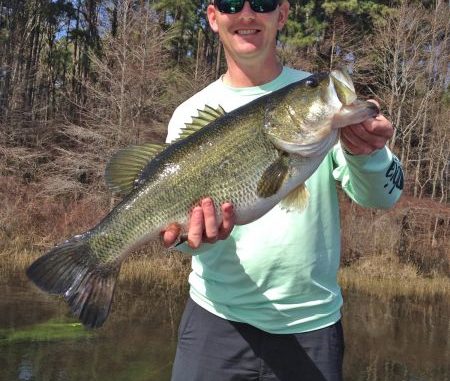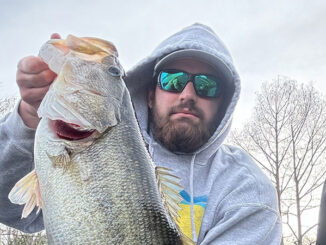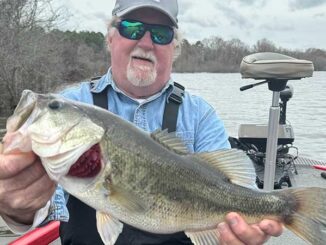
Big bass being caught shallow and deep
I arrived at Toledo Bend on Friday ready to do battle with some of the huge bass for which the reservoir has become known. Unfortunately, I never got tuned in.
But that doesn’t mean there aren’t some quality fish being caught.
In addition to the double-digit bass being entered into the Toledo Bend Lunker Program, solid chunks are being caught and weighed into tournamnets on a regular basis.
And if you are in the right areas you can catch them pretty much any way you prefer.
If you like fishing staging, well, a 32-pound limit of fish won the Texas Team Trail event held Saturday out of Cypress Bend — and those bass reportedly came on football jigs in 8 to 12 feet of water. The stringer was anchored by a 9.81-pounder.
But if you’re ready to do battle for bedding bass, that’s an option, too. A 28.6-pound sack was caught by a pair of bed fishermen north of Pendleton Bridge and weighed into the Texas Team Trail tournament. That was enough for second place in the event.
That stringer, which was good enough for second place, included a 10.88-pounder.
In fact, bed fishing was how Houston angler Austin Juckett and Alexandria’s Jacob Williford caught a couple of fish that topped 6 pounds on Saturday.
The pair of anglers began the day working Senkos through holes in and along edges of hay grass beds in 5 to 8 feet of water around the Indian Mounds. And they caught some nice fish.
But they soon noticed bass were on beds, so they moved in and started working them.
“Positioning the boat between the bank and the hay grass, we were able to see quite a few big fish,” Juckette said. “Some of the bigger fish were locked on (beds), but the majority of the fish we saw are smaller buck bass.”
The anglers focused on the bigger bass, and Williford convinced a 6-pounder to attack a lure while Juckett sunk the hook into an 8.14-pounder.
“We … caught most of them on creature baits such as the Berkley Havoc Pit Boss in watermlon and green pumpkin, and also on the Zoom lizard in watermelon red,” Juckett said.
Juckett’s big fish, however, came on a punching rig.
“I cast past the bed and reeled it slowly back toward the fish, letting the bait settle down right on top of the bed,” he explained. “She nosed up to it, and I shook the rod tip once and she annihilated it.”
What about punching hay grass, which some anglers have learned can produce some really big bass?
Youngsville’s John Pecoraro and I headed out from Indian Mounds on Saturday morning, and put in a full day of pitching heavy weights in search of some quality fish.
We worked beds all through Indian Mounds, Housen and as far north as Lowes Creek. There were a few fish, but the action was far from hectic.
Pecoraro said he thinks it’s still a little early for this bite.
“We caught them punching hay grass last year in February, but it’s really a little early,” he said.
But this strategy will come on as the spring ages.
“The sun warms up that grass, and the fish pull up into it,” Pecoraro said.
And hay grass will produce bass until the mats get too thick to punch with even the heavier weights — especially when shad start their breeding ritual by April or so.
“When the shad spawn starts, the bass will definitely be there,” Pecoraro said. “They’re not there because of the water temperature; they’re there because the shad are there.
“But you can really catch them then.”
Click here to learn his tips for success, as well as how to gear up for this grueling but rewarding tactic.
One bite that seems to have ebbed is the one centered on flooded bushes north of Pendleton Bridge. Pecorarao said bass were holding in this type of cover a couple of weeks ago, but when he and I arrived Friday afternoon the water had dropped a few feet. That left less than 3 feet of water around most of the bushes, and he managed only a couple of fish. He did break off on one fish that he believed was heavier.
“You have to have enough water around the bushes for the fish to feel comfortable,” Pecoraro said. “When it drops like that, they pull out.”


